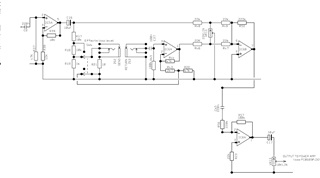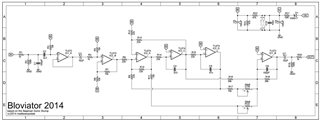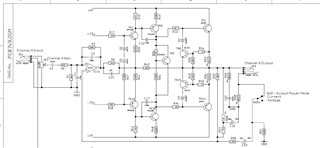- Ask a related questionWhat is a related question?A related question is a question created from another question. When the related question is created, it will be automatically linked to the original question.
This thread has been locked.
If you have a related question, please click the "Ask a related question" button in the top right corner. The newly created question will be automatically linked to this question.
Hello TI Audio World,
I'm working on a Guitar audio processor design that calls for a TL74 Quad Op-Amp. I decided to update my design to have either OPA1644 or OPA4134. I read they are close in specs. My question is does anyone know which OPA would work best for Hign end Guitar Audio?
Hi Ervin,
OPA1644 is a more recent device, it overall it generally has better performance across the board. Specifically, configured as a non-inverting input for a guitar input amplifier it works well. The higher input impedance means that any non-linear common-mode input capacitance will translate into (unwanted) distortion. The advanced process technology here has flat capacitance vs. DC voltage (as shown on the front page). So between the two, the OPA1644 is the better choice.
One other device that would be worth looking into is the OPA1656 - it is only a dual but has lower wideband noise. Depending on the frequency range you are looking into designing, the wideband noise can dominate the total noise contribution. In many circuits though, the amplifier voltage noise is not typically the primary contributor of total noise, so, it would depend on the design.
Let me know if this helps.
Regards,
Mike
I have another question. You mentioned the OPA1656. I was planning to order these the other day but the inventory is now gone and I cant seem to find a supplier with them in stock yet. I was also looking at the OPA1612AID and they seem to be available probably due to the higher price of $8.06. Would this work even better than the OPA1656 in my Guitar amplifier?
One last question, I read online people raving about the OPA627 and the new OPA828 for sound quality being superior. I also read that Highspeed may not work well in Guitar amplification. My design calls for a TL072 with a NFB from the Speaker output to drive the input to the power amp simulating a Tube like reactance. I thought about placing a OPA627 in the location and I bought one to try but was not able to test because I currently have a 2 channel layout (only using one side) and needed to adapt to a single channel but the pins from the adaptor wont fit my socket. The New design will be a SOIC-8
Hi Ervin,
Yes those devices are very popular, unfortunately I don't have any way to know for sure when they are back in stock. OPA1612 is a great amplifier, however, it is bipolar (input type) and when used immediately at the front-end of a guitar input, the input current noise (1.7 pA/rthz) will multiply with the pickup resistance (varies quite a bit, say typical is 10 kOhm) to become the dominant noise source (17 nV/rthz). We would typically recommend FET-type inputs for guitars (hence the TL072 recommendation).
OPA627 has been very popular for decades but is an older, more expensive technology. OPA828 uses modern JFET inputs and would also be a very good choice for guitar inputs. High speed amps. are sometimes desirable in audio for very high slew rates but this of course is up for argument, many times the slew is limited in other areas besides the amp. Regarding feedback from the speaker, I know many tube designs use feedback directly from the speaker, my understanding is that was used to reduce the gain and help with the overall linearity and dynamic range, but, I think this is too much of a generalization to be useful. It certainly is true though that the THD produced by a typical guitar tube amp. first stage is much higher than what you would get from an op-amp gain stage, primarily because the op-amp uses high open-loop gain in a closed-loop configuration to correct for any non-linear errors, whereas a guitar amp. first stage is typically open-loop triode (12AX7, etc.) configuration. This is why we feature higher bandwidths for audio devices - because high GBW will keep AOL very high through the audio frequency range, which means the distortion can be maintained at very low levels through the higher frequency range.
I don't want to speculate on the sound or even/odd order harmonic content of our amps. on this forum because it may lead to an infinite black hole...
We will soon have available a board that can take a smaller package and translate to an SOIC-8 footprint, unfortunately this isn't online yet but keep an eye out over the next couple of months.
Hope this helps,
Regards,
Mike
Michael,
I've very excited to here the OPA828 might be a good candidate for my application. I want to explain a little more so you understand how these Opamps are being used. For the Guitar input, I'm using a JFE150 paired with a OPA202ID for the first stage. the remaining stages are Darlington's, The OpAmps in question are in the Effect loop Send/Return which would be driving and buffering the Line level signal sent to external multi-FX processor or pedals otherwise will be in bypass. The next set of Op amps are in a BBE sonic maximizer type circuit to enhance Treble and BASS, and the final Opamps is the power amp input driver. So which style Op-Amp would you recommend for maximum sound quality, tone, and low noise. I'm trying to place and orders on the chips for my prototypes.
Ervin,
It is cool to see that you are using the JFE150 and OPA202! I actually created an EVM with this combination on our website that is from my Application Note. The noise performance is fantastic with this setup. Great choice for the first stage! I wanted to jump into the conversation as well given that audio is my passion. All of the amplifiers referenced above are great and each can be used for specific purposes.
For example if you need high gain and high current drive the OPA1656 fits the bill very well here. It has 150dB typical Aol at 600 ohms! If you need even more current output it is great combined with the BUF634A. The GBW is 20MHz in a gain of 1 and it can provide a lot of current on its output. Using this for something like a tone control circuit in subsequent stages following your front end circuit you have chosen is a great choice.
The OPA1612 has very good noise performance as bipolar devices are known for, with the trade off of higher input bias current as Mike mentioned. All that to say, that with these trade offs, sound quality can be impacted by using a device that would be better suited on one stage for another. For example using a low impedance front end that would load the guitar signal down too much over a high impedance JFET front end that would be better suited for the first stage preserving the signal.
If you are driving headphones, a device such as the INA1620 is a great choice because it can drive very high end, high impedance headphones and even low impedance headphones. With its built in thin film resistors with resistor matching, the common mode performance is fantastic.
If you have any schematics we can help with to identify trade offs using different parts, we would be happy to help guide these decisions.
Best Regards,
Chris Featherstone
Chris,
Thank you for joining !! Here are some Schematics readily available on the web from Marshall that are textbook for the style of amp project I'm asking about. I wouldn't post my designs on a public forum.
I edited this in paint removing reverb circuits to focus on the FX loop. Feeding this circuit would be the volume coming from the EQ Tone stack post pre-amp gain stages. And this then outputs to the power amp.

The BBE Circuit is similar to this Pedal version.

And last the Power amp mainly the feed back and opamp design to use a OPA828?

Hi Ervin,
There's a lot of circuits to consider here, I'll try to give some general feedback from first to last, but my general summary will be this: you will probably not see much difference between a high performance OPA164X and a lower cost OPA1678 for most of these for the circuits shown. Here's a few points about the TL072 (TL074 is the quad) - it is a lower power part very common in battery-powered applications. Since Iq is lower, noise is somewhat higher. An additional shortcoming of the lower power is that generally lower power amps. do not have as high of output drive capability. So what this means is that many circuits in this space use resistors on the order of 10k Ohms, which have thermal noise of ~12 nV/rthz (there are other tradeoffs for THD as well but for guitar I am going to assume this is negligible). This level of noise is on par with the TL072 (21 nV/rthz @ 10 kHz) so there is no point in picking lower-value resistors. However when you jump to a device like OPA1656, Iq and output current drive is much higher, and noise is much lower. This means generally the resistors that are selected need to be much lower to really feature the low-noise performance of OPA1656. So overall, in the circuits above, you'll have to lower resistances, and burn more power to push your noise floor down.
In the first circuit, this buffer has resistor-based attenuation that will contribute a lot of noise. Not sure what the input impedance is, but, the noise is not very low due to the resistor divider, OPA1678 or OPA1679 recommended here will offer a slight noise reduction from TL072.
The second schematic is a pedal so of course it is low power - but otherwise it is an active filter using a state variable architecture. I assume in your amp. you aren't too power-concerned, so I'll recommend a few higher power amplifiers. I don't know the frequency bands of concern - if you are really trying to add a lot of gain in low frequencies, then a JFET input (OPA1641) will keep noise low in low-frequency bands. In general, for a normal A-weighted integrated noise figure, the wideband noise will dominate though, in which case the OPA1656 will give the lowest noise. For many active filter cases, the the OPA1678 or TL072 will be low enough noise depending on the resistors used.
The third schematic, with the amp. being used as a discrete output stage buffer, power amp. buffer, I see the amp. in the local loop is gain of ~40, so certainly would benefit from a lower noise stage. One thing worth pointing out is that the OPA828 has a slew boost circuit that is a non-linear boosting stage - this can help with transients but sometimes can alter the sound. For this stage, I could see an OPA1656 (BTW OPA1655 is the single version) or OPA828 could work, always best to test both for audible differences.
I hope this helps. If you want to dig deeper with your actual circuits we can connect directly also, let me know.
Regards,
Mike
Ervin,
Also, just to make sure I don't leave this out - for those amplifiers that are not high impedance (i.e. < 1 kOhm) or guitar inputs, a bipolar amp. will offer the BEST possible noise for the same Iq and low 1/f noise. This is where OPA1611/12 or OPA1601/2 can shine.
Regards,
Mike
Mike & Chris thank you so much, Your explanation and suggestions put me in the right direction to finalize and order my components. I read so many reviwes raving about differnent OpAmps (some obsolete now) and Nobody explaining the differences between the input types other than Text Book. Then I have to remind myself that most of the guys are talking about Hi-Fi systems and what works for them might not work for Guitar amplifiers. Two weeks ago I ordered OPA2134PA and OPA1644DR just to try A/B comparison from the TL072 (074) in circuits 2 & 3 and I did notice a difference mainly on the clarity was a hair brigher and the low end was more prononced but overall sound was almost the same. These chips werent ideal but all that was instock at the time. Honestly a slight turn of the EQ controls would have yeided the same result but I figured why not put a even better chip ideal for the appilication would yield even better results. I also bought a OPA1655DR and a OPA627 single amps but my adaptor pins would not fit my changible sockets so I wasnt able to test them. Chips are harder to find than two weeks ago so now I dont have much time to continue to experiment, You have sent me in the right direction to go aquire these chips for my first run of amps and hopefully by the time I start a new batch they will be back instock.
Thank You Again
Ervin Williams
Michael,
I just want to report I was able to place a order with TI to get a good supply of OPA1656 and OPA828 and they are being shipped. However I was not able to find OPA1644 in 14 SOIC but I did find a small supply of OPA4134 online. I currently have a few OPA1644 for my initial prototypes so I ordered the OPA4134 as my backup until more OPA1644 are available. What is your Opinion of this amp in my application comparatively? I also want to note I have a few OPA627 to try in my initial prototypes for the highspeed current feedback power amp. Other than being an older more expensive to manufacturing process, does all your comments about using the OPA828 apply to it also or will this Amp perform slightly different?
Thank You
Ervin
Hi Ervin,
Glad to hear about the availability.
Both OPA4134 and OPA1644 are good amps, but the OPA1644 is a JFET front-end with bipolar secondary and output stages. You can see that OPA1644 has higher AOL, lower THD and noise all for a lower quiescent current; this is mainly due to the bipolar process that the OPA1644 is built on. From that perspective, it is a better amp. Of course the way it sounds will be important, depending on the thermal noise/gain/system noise floor/etc., you may not hear a difference.
OPA627 has always had an excellent reputation for sound quality, but how much of that is quantifiable into specs or simply subjective is tough to determine. The old process technology for OPA627 used dielectric isolation, whereas the OPA828 has the same JFET technology as OPA1644, yielding very low voltage coefficient on the input capacitance, effectively reducing THD as input impedance is increased. Note the OPA627 graph shows THDN at +/- 10 V, whereas the OPA1644 and OPA828 use +/3 V. Since noise dominates the THDN at lower amplitudes, it will continue to reduce vs. output amplitude. But, both have great 1/f nose and THDN overall, and fairly flat open-loop output impedance, so there shouldn't be any major audible differences.
Hope this helps,
Mike
I think a lot of the "love" for the OPA627 is simply the cargo-cult mentality that is part of the audiophile world. It's certainly a fine part, and when it was introduced (along with its brother the OPA637) it was quite the step forward.
But it really is an ancient part, and newer devices offer equal or superior performance, both in electrical terms and in cost.